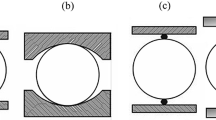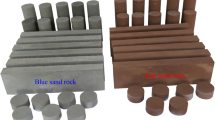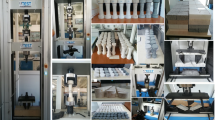Abstract
Elastic properties of rocks, including Young’s modulus and Poisson’s ratio, are usually obtained from the uniaxial compressive strength (UCS) test, while tensile strength is obtained from direct or indirect (Brazilian) tensile test. In this paper, we developed an analytical model as well as an improved test procedure, called modified Brazilian tensile (MBT) test, which can simultaneously measure the tensile strength, Young’s modulus and Poisson’s ratio in a single test by attaching two strain gauges at the center of each end face of the specimen. To validate the proposed model, both the UCS and modified Brazilian tensile tests were conducted using two types of aluminum alloy (AL 6061 and AL 7075). Results showed that the Young’s modulus obtained from UCS tests and MBT tests are within the range of experimental error. Poisson’s ratios determined from the two test methods were consistent. The proposed model was further validated with Colton sandstones. The Young’s modulus and the Poisson’s ratio obtained from the UCS test and the MBT test agreed well. We also conducted numerical modeling for further comparison, and the results also verified the reasonableness of the proposed model.
















Similar content being viewed by others
References
Amadei B, Rogers JD, Goodman RE (1983) Elastic constants and tensile strength of anisotropic rocks. International Society for Rock Mechanics and Rock Engineering, pp 189–196
Andreev GE (1991) A review of the Brazilian test for rock tensile strength determination. Part II: calculation formula. Min Sci Technol 13:457–465
Chau KT, Wei XX (2001) A three-dimensional analytic solution for the Brazilian test. International Society for Rock Mechanics and Rock Engineering, Bei**g, China, pp 141–144, 11–14 September 2001
Colback PSB (1966) An analysis of brittle fracture initiation and propagation in the Brazilian test. International Society for Rock Mechanics and Rock Engineering, Lisbon, pp 385–391, 25 September–1 October 1966
Fairhurst C (1964) On the validity of the Brazilian test for brittle materials. Int J Rock Mech Min Sci 1:535–546
Hadley WO, Hudson WR, Kennedy. TW (1998) A method of estimating tensile properties of materials tested in indirect tension. Research report number 98-7 of evaluation of tensile properties of subbases for use in new rigid pavement design
Hondros G (1959) Materials of a low tensile resistance by the Brazilian (indirect tensile) test with particular reference to concrete. Aust J Appl Sci 10(3):243–268
Kwok CY, Duan K (2015) DEM simulation of fracture process of inherently anisotropic rock under Brazilian test condition. American Rock Mechanics Association, San Francisco, pp 1–7, 28 June–1 July 2015
Li DY, Ngai L, Wong Y (2013) The Brazilian disc test for rock mechanics applications: review and new insights. Rock Mech Rock Eng 46:269–287
Li B, Li H, Guo B, Cai X, Konggidinata M (2017a) A new numerical solution to predict the temperature profile of gas-hydrate-well drilling. Soc Pet Eng. https://doi.org/10.2118/185177-PA
Li B, Li H, Guo B, Chang X (2017b) Effect of cement sheath induced stress on well integrity assessment in carbon sequestration fields. J Nat Gas Sci Eng 46:132–142. https://doi.org/10.1016/j.jngse.2017.07.014
Li H, Lai B, Liu H-H, Zhang J, Georgi D (2017c) Experimental Investigation on Brazilian tensile strength of organic-rich gas shale. Soc Pet Eng. https://doi.org/10.2118/177644-PA
Li B, Zhou F, Li H, Tian Y, Yang X, Zhang Y, Feng Y (2018a) Experimental Investigation on the fracture conductivity of ultra-deep tight gas reservoirs: especially focus on the unpropped fractures. American Rock Mechanics Association, Seattle, pp 1–9, 17–20 June 2018
Li B, Zhou F, Li H, Duguid A, Que L, Xue Y et al (2018b) Prediction of CO2, leakage risk for wells in carbon sequestration fields with an optimal artificial neural network. Int J Greenh Gas Control 68:276–286
Muskhelishvili HN (1958) Some basic problem in mathematic elastic mechanics (translated by Zhao Huiyuan). Science Press, Bei**g
Nakashima S, Taguchi K, Moritoshi A, Shimizu N, Funatsu T (2013) Loading conditions in the Brazilian test simulation by DEM. American Rock Mechanics Association, San Francisco, pp 1–6, 23–26 June 2013
Serati M, Alehossein H, Erarslan N, Williams DJ (2013) 3D elastic solutions for point load and Brazilian indirect tensile strength tests. Int Soc Rock Mech Rock Eng
Wang QZ, Jia XM, Kou SQ, Zhang ZX, Lindqvist PA (2004) The flattened Brazilian disc specimen used for testing elastic modulus, tensile strength and fracture toughness of brittle rocks: analytical and numerical results. Int J Rock Mech Min Sci 41(2):245–253. https://doi.org/10.1016/s1365-1609(03)00093-5
Winograd EA, Bosco S, Álvarez JP, Mendoza Álvarez M, Hryb D, Sánchez M (2015) Characterization of mechanical properties of rocks using numerical simulations and image analysis. American Rock Mechanics Association, San Francisco, pp 1–7, 28 June–1 July 2015
Ye JH, Wu FQ, Sun JZ (2009) Estimation of the tensile elastic modulus using Brazilian disc by applying diametrically opposed concentrated loads. Int J Rock Mech Min Sci 46:568–576
Acknowledgements
This research was supported by Science Foundation of China University of Petroleum, Bei**g (no. 2462017YJRC041 and no. 2462016YJRC033), by the China State Key Laboratory of Petroleum Resources and Prospecting Foundation (no. PRP/indep-04-1608, no. PRP/indep-2-1704 and no. PRP/indep-4-1703), by the Innovation Fund of China National Petroleum Corporation (no. 2017D-5007-0308), and by the National Science and Technology Major Project of China, founding nos. 2016ZX05051 and 2017ZX05030. The authors appreciate Ben Li, Yanhui Han, Zhixing Wang and **n Zhao for the technical insights and grammar check on this paper. The authors are grateful to Aramco Services Company for permission to publish this work.
Author information
Authors and Affiliations
Corresponding author
Additional information
Publisher’s Note
Springer Nature remains neutral with regard to jurisdictional claims in published maps and institutional affiliations.
Appendices
Appendix A: Derivation of Mathematical Model for Elastic Modulus and Poisson’s Ratio in Brazilian Tensile Test with Different Geometries of Strain Gauges
See Fig. 15.
The solution for an isotropic Brazilian disc subjected to concentrated loads is (Muskhelishvili 1958):
where \({\sigma _x}\) and \({\sigma _y}\) are normal stress along x- and y-directions, respectively, in MPa; \({\tau _{xy}}\) is the shear stress, in MPa; P is the load, in N; D is the diameter of the tested disc, in mm; L is the length of the disc, in mm; \({\theta _1}\) and \({\theta _2}\) are positive when the point A is at the right of load P, and they are negative when A is at left of load P. \({r_1}\) and \({r_2}\) are the distances from point A to the loading points B and C. According to the triangle relations:
According to right triangle regulation, the coordinate of point A (x, y) is:
Then:
Put (38), (39) and (40) into (33), (34) and (35):
Put Eqs. (38)–(43) into Eqs. (30), (31) and (32), we get the analytical solution of stress state for the isotropic rock disc:
Two strain gauges, measuring strains in x- and y-directions, are pasted at the center of both sides of the Brazilian disc (Fig. 16). The geometry of both strain gauges are not necessary identical. For general, we assume that two stain gauges’ geometry are not the same. For the strain gauge used to measure tensile strain the half-width is d1 and the half-length is l1, see Fig. 16a. For the strain gauge used to measure compressive strain the half-width is d2 and the half-length is l2, see Fig. 16b. The width and length of strain gauge maybe varied by strain gauge manufactures.
For strain gauge #1 with half-length of \({l_1}\) and half-width of \({d_1}\), the average stress along x-axial and y-axial are:
Similarly, for strain gauge #2 which is attached to the other end of disc and has half-length of \({l_2}\) and half-width of \({d_2}\), the average stress along x-axial and y-axial are:
Letting,
And integrating Eqs. (47)–(50) gives:
For a given specimen and strain gauges, disc diameter\(~D\), disc length \(L\) and strain gauge geometry parameters \({l_1}\), \({d_1}\), \({l_2}\) and \({d_2}\)are constants. Grou** those constants to simplify Eqs. (59–62) and letting:
We can rewrite Eqs. (49)–(62) as:
According to linearly elasticity theory, the tensile strain (\({\varepsilon _x}\)) and compressive strain (\({\varepsilon _y}\)) are generated by both \(\overline {{{\sigma _x}}}\) and \(~\overline {{{\sigma _y}}}\).
where \({\varepsilon _x}\) is strain in x-direction; \({\varepsilon _y}\) is strain in y direction; \({E_{\text{t}}}\) is the tensile elastic modulus; and \({{\nu}_{\text{t}}}\) is the tensile Poisson’s ratio.
Substituting Eqs. (67)–(70) into Eqs. (71) and (72) gives:
From Eqs. (73) and (74), we can obtain the ratio of the tensile strain (\({\varepsilon _x}\)) to compressive strain (\({\varepsilon _y}\)) ratio:
Then tensile Poisson’s ratio can be expressed as:
Exchanging \({\varepsilon _x}\) and \({E_{\text{t}}}\) in Eq. (71), we get tensile elastic modulus formula related to \(P,~{\varepsilon _x}\) and \({{\nu}_{\text{t}}}\):
Also, exchanging \({\varepsilon _y}\) and \({E_{\text{t}}}\) in Eq. (72), we get another tensile elastic modulus formula related to \(P,~{\varepsilon _y}\) and \({{\nu}_{\text{t}}}\):
As can be seen from Eqs. (76, 77) (and/or Eq. 78), both Poisson’s ratio and Young’s modulus are function of load (P) and radial and axial strains (\({\varepsilon _x}\) and \({\varepsilon _y}\)), and \({\varepsilon _x}\) and \({\varepsilon _y}\) are stress dependent. To eliminate stress dependent elastic constants, we use an alternative method based on the superposition principle. Since the elastic properties are obtained from the linear part of stress–strain curve, the tensile Poisson’s ratio and Young’s modulus can also be written as:
In this way, we can determine tensile Poisson’s ratio and tensile Young’s modulus from a single Brazilian tensile test.
Note The stress that used to calculate the tensile Young’s Modulus and Poisson’s ratio is the average stress in the strain gauge measured area. If the strain gauge measured area is small enough, the stress is uniform distributed in this area and the average stress can be used to calculate the tensile Young’s modulus and Poisson’s ratio (Figs. 8, 9). However, if the strain gauge measure area is so large that exceed the stress uniform distributed section, the calculation is questionable. Thus, the strain gauge dimension (length/width) must be optimized considering the dimension of the test sample.
Appendix B: Detailed Integration of Average Tensile Stress and Average Compressive Stress
-
1.
Integration of average tensile stress
The average stress along x-axis is:
$$\overline {{{\sigma _x}}} =\frac{1}{l}\mathop \int \limits_{0}^{l} \frac{{2P}}{{\pi L}}\left\{ {\frac{{\left( {\left( {\frac{D}{2}} \right) - y} \right){l^2}}}{{{{\left( {{{\left( {\left( {\frac{D}{2}} \right) - y} \right)}^2}+{l^2}} \right)}^2}}}+\frac{{\left( {\left( {\frac{D}{2}} \right)+y} \right){l^2}}}{{{{\left( {{{\left( {\left( {\frac{D}{2}} \right)+y} \right)}^2}+{l^2}} \right)}^2}}} - \frac{1}{D}} \right\}{\text{d}}y,$$(82)$$\overline {{{\sigma _x}}} =\frac{{2P}}{{\pi Ll}}\left\{ {\mathop \int \limits_{0}^{l} \left[ {\frac{{\left( {\left( {\frac{D}{2}} \right) - y} \right){l^2}}}{{{{\left( {{{\left( {\left( {\frac{D}{2}} \right) - y} \right)}^2}+{l^2}} \right)}^2}}}} \right]dy+\mathop \int \limits_{0}^{l} \left[ {\frac{{\left( {\left( {\frac{D}{2}} \right)+y} \right){l^2}}}{{{{\left( {{{\left( {\left( {\frac{D}{2}} \right)+y} \right)}^2}+{l^2}} \right)}^2}}}} \right]{\text{d}}y - \mathop \int \limits_{0}^{l} \frac{1}{D}{\text{d}}y} \right\}.$$(83)We integrate Eq. (83) separately:
-
1.1
$$\mathop \int \limits_{0}^{l} \left[ {\frac{{\left( {\left( {\frac{D}{2}} \right) - y} \right){l^2}}}{{{{\left( {{{\left( {\left( {\frac{D}{2}} \right) - y} \right)}^2}+{l^2}} \right)}^2}}}} \right]{\text{d}}y.$$
Let \(u=\left( {\frac{D}{2}} \right) - y,\)
$$\mathop \int \limits_{0}^{l} \left[ {\frac{{\left( {\left( {\frac{D}{2}} \right) - y} \right){l^2}}}{{{{({{(\left( {\frac{D}{2}} \right) - y)}^2}+{l^2})}^2}}}} \right]{\text{d}}y= - \mathop \int \limits_{{\frac{D}{2}}}^{{\frac{D}{2} - l}} \left[ {\frac{{u{l^2}}}{{{{({u^2}+{l^2})}^2}}}} \right]{\text{d}}u= - \frac{{{l^2}}}{2}\mathop \int \limits_{{\frac{D}{2}}}^{{\frac{D}{2} - l}} \left[ {\frac{1}{{{{({u^2}+{l^2})}^2}}}} \right]{\text{d}}{u^2}= - \frac{{{l^2}}}{2}\mathop \int \limits_{{\frac{D}{2}}}^{{\frac{D}{2} - l}} \left[ {\frac{1}{{{{({u^2}+{l^2})}^2}}}} \right]{\text{d}}({u^2}+{l^2})=\frac{{{l^2}}}{2}\left[ {\frac{1}{{{u^2}+{l^2}}}} \right]_{{\frac{D}{2}}}^{{\frac{D}{2} - l}}=\frac{{{l^2}}}{2}\left[ {\frac{1}{{{{\left( {\frac{D}{2} - l} \right)}^2}+{l^2}}} - \frac{1}{{{{\left( {\frac{D}{2}} \right)}^2}+{l^2}}}} \right]$$(84) -
1.2
$$~\mathop \int \limits_{0}^{l} \left[ {\frac{{\left( {\left( {\frac{D}{2}} \right)+y} \right){l^2}}}{{{{\left( {{{\left( {\left( {\frac{D}{2}} \right)+y} \right)}^2}+{l^2}} \right)}^2}}}} \right]{\text{d}}y.$$
Let \(v=\left( {\frac{D}{2}} \right)+y\)
$$\begin{gathered} \mathop \int \limits_{0}^{l} \left[ {\frac{{\left( {\left( {\frac{D}{2}} \right)+y} \right){l^2}}}{{{{\left( {{{\left( {\left( {\frac{D}{2}} \right)+y} \right)}^2}+{l^2}} \right)}^2}}}} \right]{\text{d}}y={l^2}\mathop \int \limits_{{\frac{D}{2}}}^{{\frac{D}{2}+l}} \left[ {\frac{v}{{{{({v^2}+{l^2})}^2}}}} \right]{\text{d}}v=\frac{{{l^2}}}{2}\mathop \int \limits_{{\frac{D}{2}}}^{{\frac{D}{2}+l}} \left[ {\frac{1}{{{{({v^2}+{l^2})}^2}}}} \right]{\text{d}}{v^2}=\frac{{{l^2}}}{2}\mathop \int \limits_{{\frac{D}{2}}}^{{\frac{D}{2}+l}} \left[ {\frac{1}{{{{({v^2}+{l^2})}^2}}}} \right]{\text{d}}({v^2}+{l^2})=\frac{{{l^2}}}{2}\left[ { - \frac{1}{{{v^2}+{l^2}}}} \right]_{{\frac{D}{2}}}^{{\frac{D}{2}+l}}= - \frac{{{l^2}}}{2}\left[ {\frac{1}{{{{\left( {\frac{D}{2}+l} \right)}^2}+{l^2}}} - \frac{1}{{{{\left( {\frac{D}{2}} \right)}^2}+{l^2}}}} \right] \end{gathered}$$(85) -
1.3
$$- \mathop \int \limits_{0}^{l} \frac{1}{D}{\text{d}}y= - \frac{l}{D}.$$
Then put the results of 1.1, 1.2 and 1.3 into the following equation:
$$\begin{aligned} \overline {{{\sigma _x}}} & =\frac{{2P}}{{\pi Ll}}\left\{ {\mathop \int \limits_{0}^{l} \left[ {\frac{{\left( {\left( {\frac{D}{2}} \right) - y} \right){l^2}}}{{{{\left( {{{\left( {\left( {\frac{D}{2}} \right) - y} \right)}^2}+{l^2}} \right)}^2}}}} \right]{\text{d}}y+\mathop \int \limits_{0}^{l} \left[ {\frac{{\left( {\left( {\frac{D}{2}} \right)+y} \right){l^2}}}{{{{({{(\left( {\frac{D}{2}} \right)+y)}^2}+{l^2})}^2}}}} \right]{\text{d}}y - \mathop \int \limits_{0}^{l} \frac{1}{D}{\text{d}}y} \right\} \\ & =\frac{{2P}}{{\pi Ll}}\left\{ {\frac{{{l^2}}}{2}\left[ {\frac{1}{{{{\left( {\frac{D}{2} - l} \right)}^2}+{l^2}}} - \frac{1}{{{{\left( {\frac{D}{2}} \right)}^2}+{l^2}}}} \right] - \frac{{{l^2}}}{2}\left[ {\frac{1}{{{{\left( {\frac{D}{2}+l} \right)}^2}+{l^2}}} - \frac{1}{{{{\left( {\frac{D}{2}} \right)}^2}+{l^2}}}} \right] - \frac{l}{D}} \right\} \\ & =\frac{P}{{\pi Ll}}\left\{ {{l^2}\left[ {\frac{1}{{{{\left( {\frac{D}{2} - l} \right)}^2}+{l^2}}} - \frac{1}{{{{\left( {\frac{D}{2}+l} \right)}^2}+{l^2}}}} \right] - \frac{{2l}}{D}} \right\}. \\ \end{aligned}$$(86)Let
$$A=\left( {\frac{D}{2}} \right) - l,$$(87)$$B=\left( {\frac{D}{2}} \right)+l.$$(88)Then
$$\overline {{{\sigma _x}}} =\frac{P}{{\pi Ll}}\left\{ {{l^2}\left[ {\frac{1}{{{A^2}+{l^2}}} - \frac{1}{{{B^2}+{l^2}}}} \right] - \frac{{2l}}{D}} \right\},$$(89)$$\overline {{{\sigma _x}}} =\frac{P}{{\pi L}}\left\{ {l\left[ {\frac{1}{{{A^2}+{l^2}}} - \frac{1}{{{B^2}+{l^2}}}} \right] - \frac{2}{D}} \right\}.$$(90)
-
1.1
-
2.
Integration of average compressive stress
The average stress along y-axis is:
$$\overline {{{\sigma _y}}} = - \frac{1}{l}\mathop \int \limits_{0}^{l} \frac{{2P}}{{\pi L}}\left\{ {\frac{{{{\left( {\left( {\frac{D}{2}} \right) - l} \right)}^3}}}{{{{\left( {{{\left( {\left( {\frac{D}{2}} \right) - l} \right)}^2}+{x^2}} \right)}^2}}}+\frac{{{{\left( {\left( {\frac{D}{2}} \right)+l} \right)}^3}}}{{{{\left( {{{\left( {\left( {\frac{D}{2}} \right)+l} \right)}^2}+{x^2}} \right)}^2}}} - \frac{1}{D}} \right\}{\text{d}}x,$$(91)$$\overline {{{\sigma _y}}} = - \frac{{2P}}{{\pi lL}}\mathop \int \limits_{0}^{l} \left\{ {\frac{{{{\left( {\left( {\frac{D}{2}} \right) - l} \right)}^3}}}{{{{\left( {{{\left( {\left( {\frac{D}{2}} \right) - l} \right)}^2}+{x^2}} \right)}^2}}}+\frac{{{{\left( {\left( {\frac{D}{2}} \right)+l} \right)}^3}}}{{{{\left( {{{\left( {\left( {\frac{D}{2}} \right)+l} \right)}^2}+{x^2}} \right)}^2}}} - \frac{1}{D}} \right\}{\text{d}}x.$$(92)Put Eq. (87) and Eq. (88) into Eq. (92), get
$$\overline {{{\sigma _y}}} = - \frac{{2P}}{{\pi lL}}\mathop \int \limits_{0}^{l} \left\{ {\frac{{{A^3}}}{{({{({A^2}+{x^2})}^2}}}+\frac{{{B^3}}}{{{{({B^2}+{x^2})}^2}}} - \frac{1}{D}} \right\}{\text{d}}x,$$(93)$$\overline {{{\sigma _y}}} = - \frac{{2P}}{{\pi lL}}\left\{ {\mathop \int \limits_{0}^{l} \left[ {\frac{{{A^3}}}{{({{({A^2}+{x^2})}^2}}}} \right]{\text{d}}x+\mathop \int \limits_{0}^{l} \left[ {\frac{{{B^3}}}{{({{({B^2}+{x^2})}^2}}}} \right]{\text{d}}x - \mathop \int \limits_{0}^{l} \frac{1}{D}{\text{d}}x} \right\}.$$(94)We integrate Eq. (94) separately:
-
2.1
$$\mathop \int \limits_{0}^{l} \left[ {\frac{{{A^3}}}{{({{({A^2}+{x^2})}^2}}}} \right]{\text{d}}x.$$
Let \(\frac{x}{A}=v\), then
$$\mathop \int \limits_{0}^{l} \left[ {\frac{{{A^3}}}{{({{({A^2}+{x^2})}^2}}}} \right]{\text{d}}x=\mathop \int \limits_{0}^{{\frac{l}{A}}} \frac{1}{{{{(1+{v^2})}^2}}}{\text{d}}v.$$(95)Let
$$v=\tan t.$$(96)Then \({\text{d}}v={\sec ^2}t{\text{d}}t,\)
$$\mathop \int \limits_{0}^{{\frac{l}{A}}} \frac{1}{{{{(1+{v^2})}^2}}}{\text{d}}v=\mathop \int \limits_{0}^{{\arctan \frac{l}{A}}} \frac{1}{{{{\sec }^4}t}}{\sec ^2}t{\text{d}}t=\mathop \int \limits_{0}^{{\arctan \frac{l}{A}}} {\cos ^2}t{\text{d}}t=\mathop \int \limits_{0}^{{\arctan \frac{l}{A}}} \left( {\frac{{~\cos 2t+1}}{2}} \right){\text{d}}t=\frac{1}{2}[\sin t\cos t]_{0}^{{\arctan \frac{l}{A}}}+\frac{1}{2}\arctan \frac{l}{A},$$(97)$$\sin t\cos t=\frac{{\sin t{{\cos }^2}t}}{{\cos t}}=\tan t\frac{1}{{{{\sec }^2}t}}=\frac{{\tan t}}{{{{\tan }^2}t+1}}.$$(98)Then
$$\sin t\cos t=\frac{v}{{{v^2}+1}}.$$(99)$$\mathop \int \limits_{0}^{{\frac{l}{A}}} \frac{1}{{{{(1+{v^2})}^2}}}{\text{d}}v=\frac{1}{2}[\sin t\cos t]_{0}^{{\arctan \frac{l}{A}}}+\frac{1}{2}\arctan \frac{l}{A}=\frac{1}{2}\left[ {\frac{v}{{{v^2}+1}}} \right]_{0}^{{\frac{l}{A}}}+\frac{1}{2}\arctan \frac{l}{A}=\frac{1}{2}\left( {\frac{{lA}}{{{l^2}+{A^2}}}} \right)+\frac{1}{2}\arctan \frac{l}{A}=\frac{{{A^3}}}{2}\left[ {\frac{l}{{{A^2}({l^2}+{A^2})}}+\frac{1}{{{A^3}}}\arctan \frac{l}{A}} \right].$$(100) -
2.2
Similarly, we get the second part of Eq. (94):
$$\mathop \int \limits_{0}^{l} \left[ {\frac{{B^{3} }}{{((B^{2} + x^{2} )^{2} }}} \right]{\text{d}}x = \frac{{B^{3} }}{2}\left[ {\frac{l}{{B^{2} (l^{2} + B^{2} )}} + \frac{1}{{B^{3} }}\arctan \frac{l}{B}} \right].$$ -
2.3
$$- \,\mathop \int \limits_{0}^{l} \frac{1}{D}{\text{d}}x= - \frac{l}{D}.$$
Then put the integration results of 2.1, 2.2 and 2.3 into Eq. (94):
$$\begin{aligned} \overline {{{\sigma _y}}} & = - \frac{{2P}}{{\pi lL}}\left\{ {\mathop \int \limits_{0}^{l} \left[ {\frac{{{A^3}}}{{({{({A^2}+{x^2})}^2}}}} \right]{\text{d}}x+\mathop \int \limits_{0}^{l} \left[ {\frac{{{B^3}}}{{({{({B^2}+{x^2})}^2}}}} \right]{\text{d}}x - \mathop \int \limits_{0}^{l} \frac{1}{D}{\text{d}}x} \right\} \\ ~ & = - \frac{{2P}}{{\pi lL}}\left\{ {\frac{{{A^3}}}{2}\left[ {\frac{l}{{{A^2}({l^2}+{A^2})}}+\frac{1}{{{A^3}}}\arctan \frac{l}{A}} \right]+\frac{{{B^3}}}{2}\left[ {\frac{l}{{{B^2}({l^2}+{B^2})}}+\frac{1}{{{B^3}}}\arctan \frac{l}{B}} \right] - \frac{l}{D}} \right\}. \\ \end{aligned}$$(101)
-
2.1
Rights and permissions
About this article
Cite this article
Li, H., Lai, B. & Liu, H. Determination of Tensile Elastic Parameters from Brazilian Tensile Test: Theory and Experiments. Rock Mech Rock Eng 52, 2551–2568 (2019). https://doi.org/10.1007/s00603-019-1738-8
Received:
Accepted:
Published:
Issue Date:
DOI: https://doi.org/10.1007/s00603-019-1738-8




